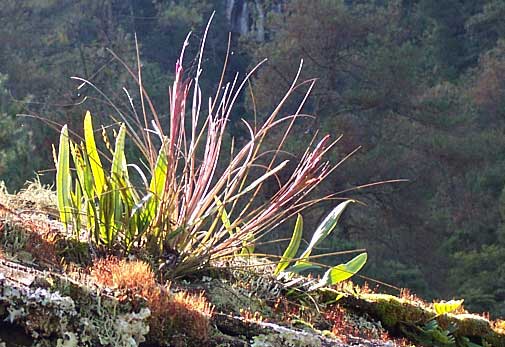Excerpts from Jim Conrad's
Naturalist Newsletter
from the December 18, 2006 Newsletter issued from Sierra Gorda Biosphere Reserve, QUERÉTARO, MÉXICO
EPIPHYTES ON SHINGLES
Back in my German days I used to backpack a lot in the Alps. I always got a kick from how the slate-tile roofs of mountaintop shepherds' huts often were thickly carpeted with lichens, mosses and other plants such as the rosette-forming little succulent sometimes called Hen-and-Chicks (genus Sempervivum) seen at http://www.wsu.edu/~lohr/wcl/SemtecForm.jpg.
Up at San Juan de los Durán the mountain air was so humid that not only were many tree branches heavy with dangling fruticose lichen but also the shingles of buildings sprouted plant populations reminiscent of what I've seen atop Alpine shepherds' huts. The plants inhabiting the shingle edges here were tropical, however, and much more colorful and diverse. A picture of such a shingle garden is shown below:

In that picture the green, upward-pointing, fingerlike items are ferns with round, spore-producing sori, or fruitdots, on their lower surfaces. I think this is PLEOPELTIS CRASSINERVATA, close to the genus Polypodium. Next to the Pleopeltis is a gray tuft of stiff, slender leaves with two narrow, reddish inflorescences arising among them. That's a bromeliad, genus TILANDSIA, probably the species BARTRAMII.
By "bromeliad" I mean that it's a member of the Tropical American plant family the Bromeliaceae, or Bromeliad Family. Nearly all bromeliads grow on trees as epiphytes. Don't confuse epiphytes with parasites. Parasites rob nutrients from their hosts while epiphytes merely use their hosts as perches, taking their nutrients from the air and rain. Most epiphytes are not parasites. Mistletoes are semi-parasitic epiphytes but bromeliads are not parasitic at all. The best-known bromeliad, by the way, is the Pineapple plant, which is very unusual in the family since it grows rooted in the ground.
Spanish Moss also is a bromeliad. In fact, Spanish Moss is also a member of the genus Tillandsia, like our roof- shingle bromeliad -- it's Tillandsia usneoides. Therefore, Spanish Moss is closely related to the bromeliad in the picture. Spanish Moss itself is unusual among bromeliads because its plants grow connected together in dangling, rope-like associations. The shingle Tillandsia is much more typical of bromeliads.